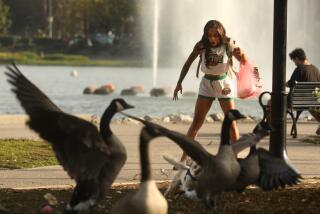‘Mother Goose’ Takes to the Skies to Teach Migration : Nature: Scientists know that when birds hatch, they attach themselves to the first thing they see and follow it around. But will they follow an aircraft to learn a migration pattern?
WARRENTON, Va. — The grassy landing strip is ready and if all goes as planned, a flock of geese will fly here later this summer, led 350 miles from Canada by an ultra-light aircraft they believe is their mother.
The experiment is designed to test the potential of what scientists call “imprinting”: when birds hatch, they attach themselves to the first thing they see and follow it around.
Birds have imprinted on people, cars and even a boat, but Canadian artist and pilot William Lishman found a new twist five years ago when he and his plane trained a gaggle of geese to fly near his Ontario home. This summer, he and a second pilot hope to test whether the birds will follow their two aircraft on a long migratory route that includes an overnight stop or two.
The birds are to land at Airlie, a sprawling conference center 50 miles from Washington, D.C., amid rural Virginia horse country.
They are to winter under the care of Lishman’s scientific partner, William Sladen, a Johns Hopkins University ecology professor emeritus who supervises Airlie’s environmental program and its collection of rare swans.
Next spring, the plan is to have Lishman lead half the radio-collared flock back to his property near Toronto. If the experiment succeeds, the birds will fly down from Canada on their own in the fall of 1994. (The other half of the flock will be left alone to see whether they find the return route on their own.)
“It is the most exciting thing I’ve ever done,” said Sladen, an international authority on penguins and waterfowl who twice received British royal honors for his work in Antarctica. “It has all sorts of wonderful potentials.”
If the experiment works on common geese, it could help restore populations of rarer birds, such as whooping cranes and trumpeter swans that have been exterminated from regions they once inhabited.
A guide is needed because species of birds such as cranes, geese and swans learn migratory routes from their parents.
On a less glamorous note, the idea could be used to move populations of nuisance geese in suburbia, where birds live year-round because they also never learned where they are supposed to migrate.
The aircraft he plans to fly weighs 250 pounds, has a 34-foot wingspan and is equipped with a camera. The wings will be painted to resemble that of a goose.
Up in Canada, three dozen goslings hatched in mid-May, and they’ve already imprinted on Lishman. Locally known as “Father Goose,” he refers to his plane as the geese’s mother.
Now, he’s training the birds to be at ease with the 30-horsepower aircraft, which looks like a glider with a reclining seat. The propeller is in the rear, so its wash keeps the geese from flying into it.
To train the geese, Lishman runs, swims and generally hangs out with the young birds, all the while carrying a tape recorder that plays the droning sound of his aircraft. He also shows them a plywood model of his metal-and-fabric craft.
“This isn’t the fun stage--it’s the hard-work stage,” Lishman said in a telephone interview during a training break.
Within a few weeks, he will climb into the aircraft and taxi down his runway, with the birds trotting after. When their wings develop enough so they can fly, in about six weeks, he will take off for short flights with them. They fly up to 1,000 feet above the ground, with a top speed of about 35 miles an hour.
After the birds and the aircraft land, the geese hop over and peck gently at the machine, their way of getting to know it.
More to Read
Sign up for Essential California
The most important California stories and recommendations in your inbox every morning.
You may occasionally receive promotional content from the Los Angeles Times.










